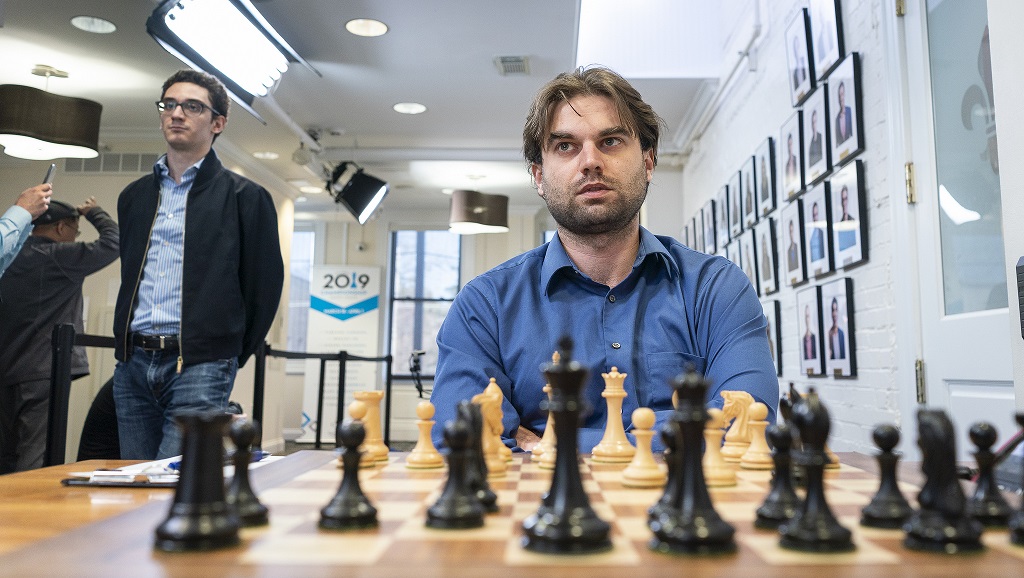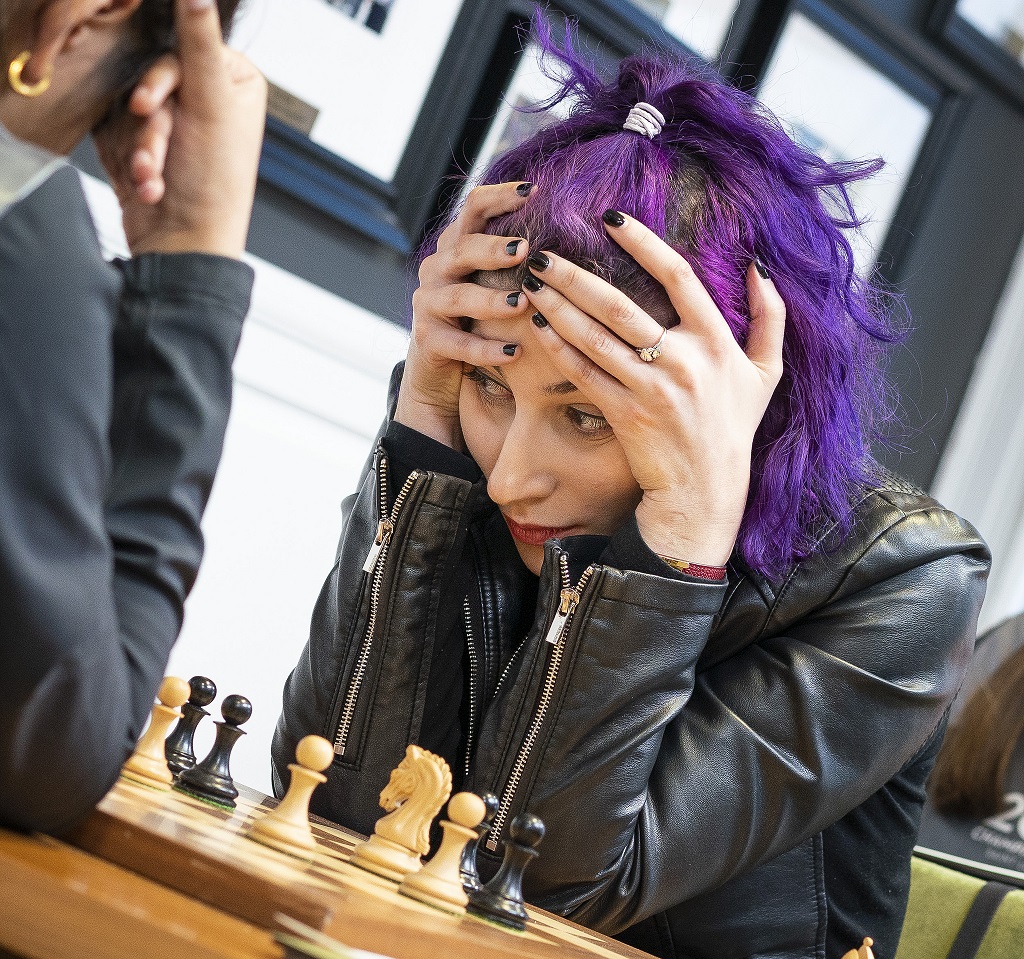


ChessBase 17 - Mega package - Edition 2024
It is the program of choice for anyone who loves the game and wants to know more about it. Start your personal success story with ChessBase and enjoy the game even more.
Not so long ago Hikaru Nakamura was the clear number one in US chess, but the inclusion of Wesley So, Fabiano Caruana and now Leinier Dominguez to the federation made it increasingly difficult to claim that spot. However, after a 2018 without much to celebrate in classical chess, Nakamura managed to get clear first at the strongest ever edition of the national championship.
He took home $50,000 and added almost fifteen points to his rating, reaching number 11 in the live ratings list after having stalled at number 16 in previous months.

The latest two US champions sharing a laugh | Photo: Lennart Ootes
It was a three-horse race when the round began, and the first one to finish his game was Fabiano Caruana, who could not create enough play with the black pieces against 2018 champion Sam Shankland. This was not a surprise for Nakamura, who mentioned in the post-game interview that he expected this to happen — he was almost certain, on the other hand, that Leinier Dominguez would win.
Shankland demonstrated he was happy with the overall result of the event, congratulating his long-time comrade on Twitter:
There's nobody on Earth I would rather be my successor. Congrats @GMHikaru!
— Sam Shankland (@GMShanky) 31 de marzo de 2019

Three players were in the fight for first when the round began | Photo: Lennart Ootes
By the time Sam and Fabiano signed the draw, all eyes were put on Leinier Dominguez v Timur Gareyev, as the prediction made by both Caruana and Nakamura seemed to be about to be confirmed — Leinier did get a large advantage with the white pieces. After having gotten the upper hand, however, the Cuban-born GM missed a big opportunity:
And Action! - How to crown positional play by tactics
There are few names which, like that of Alexei Shirov, can be associated with fantastically imaginative and tactically influenced play. Now the Latvian grandmaster is presenting a DVD on precisely that element of the game of chess. And one that is completely based on his own games.
Try your own variations on the diagram above!
White's 26.fxe5 was not the most challenging, as the computers were screaming for 26.f5, going for a kingside attack. Leinier said afterwards that he had seen the idea but that after 26...♞g5 27.♔g2 ♞f7 28.f6 g6 he could not see a clear way to continue. Thus, he decided to go for the capture on e5, which also looked good. And he was right, as White still was the one putting pressure afterwards in the game.
When the players reached the time control, White was a piece up, but Black had a pawn on b2 in return:
A difficult technical task awaited Dominguez, who had precisely made the most of these sort of small advantages throughout the tournament.
Gareyev found the right defensive manoeuvres, however, and the draw was signed after 77 moves. White was still a piece up, but the black king was active and controlled the knight's entrance squares, while also threatening to capture the all-important h-pawn:
Chess Endgames 14 - The golden guidelines of endgame play
Rules of thumb are the key to everything when you are having to set the correct course in a complex endgame. In this final DVD of his series on the endgame, our endgame specialist introduces you to the most important of these rules of thumb.
Leinier had a great tournament, especially taking into account the fact that he had not played a classical chess tournament for over two years. He shared second place with Fabiano Caruana and took home $25,000.

The hiatus did not hurt Leinier's chess strength | Photo: Lennart Ootes
A few minutes prior to Leinier and Timur finally agreeing to a draw, Nakamura had already signed the scoresheet of his eleventh round game against Jeffery Xiong with 0-1 as a result. He later confessed that he had prepared mostly for 1.e4. Against 1.d4 he chose an old weapon of his, the Dutch Defence, aware of the fact that Xiong usually does not feel very comfortable in these structures.
By move 30, Black already had an edge, but at that point Jeffery threw away an opportunity to muddy the waters:
The Dutch Stonewall - A fighting repertoire against 1.d4
In the Dutch Stonewall Black from the very first move fights for the initiative. Let Erwin l'Ami take you on a fascinating journey to the depth and attractions of this unique opening. At the end you will be rewarded with a new repertoire against 1.d4!
Instead of 32.♖b7, Xiong could have gone for 32.♖e6+, giving up the exchange but also getting a strong passed pawn on e6. After the text, however, Hikaru got a strong initiative and never looked back until getting the coveted win in 58 moves.
Resignation came after 55...♜a1+ 56.♔g2 ♜g1+ 57.♔h2 g3+ 58.♔h3 ♜h1+ (58...h5 was mate-in-seven) and White has more than enough reasons to give up at this point.

Keeping an eye... | Photo: Lennart Ootes
Hikaru talked to Maurice Ashley afterwards. When asked about his bad run in classical chess, he pointed out that he felt things could have gone a different way had he found the right moves at some very particular critical moments. This triumph, therefore, is very important for him, as he managed to get crucial victories when he felt he was in must-win situations — Hikaru particularly mentions his games against Robson, Akobian and, of course, Xiong, all wins with the black pieces.
A key factor, according to the champion, was the big support he received from the Twitch community. Hikaru has lately become a regular feature in the streaming world — a whole new way to approach chess improvement?
The "Mega" is the database every serious chessplayer needs. The database contains 7.6 million games from 1500 to 2018, in highest quality standard, full of top level analyses and completely classified.
The 2019 Women's US Champion continued her absolutely astounding run after having secured the title with a round to spare. Jennifer took down Carissa Yip to wrap up her performance in Saint Louis with nine wins and two draws, while also getting a 2½-point lead over her closest rivals. Yu already has the three norms required to become an IM and will be looking to increase her rating in order to get the title (she gained around a hundred rating points in this event).

It was a dream tournament for Jennifer | Photo: Lennart Ootes
Second place in the Women's was shared between Tatev Abrahamyan and Anna Zatonskih, after the latter was defeated for a second day in a row, this time against Sabina Foisor. A royal fork gave Sabina the victory:
Master Class Vol.2: Mihail Tal
On this DVD Dorian Rogozenco, Mihail Marin, Oliver Reeh and Karsten Müller present the 8. World Chess Champion in video lessons: his openings, his understanding of chess strategy, his artful endgame play, and finally his immortal combinations.
35.♕xf6+ ♚xf6 36.♘d5+ and Black resigned. The fact that, despite finishing with two losses, she managed to tie for second place goes to show how strong Zatonskih's play had been in the first nine rounds.

Tatev Abrahamyan ended up tied for second | Photo: Lennart Ootes
| Advertising |